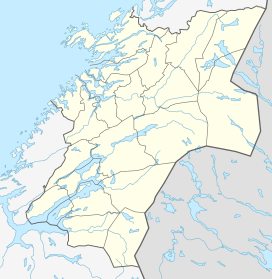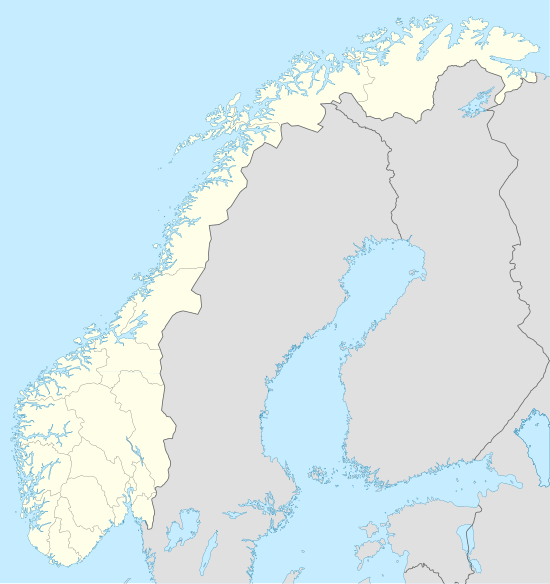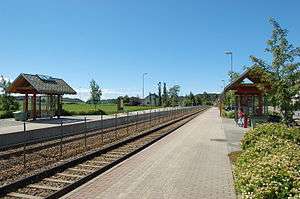Skatval
| Skatval herred | |
|---|---|
| Former Municipality | |
|
Skatval (front) and surrounding landscape as seen from Forbordsfjellet | |
| Municipality ID | NO-1715 |
| Adm. Center | Skatval |
| Area[1] | |
| • Total | 94 km2 (36 sq mi) |
| Created from | Nedre Stjørdal in 1902 |
| Merged into | Stjørdal in 1962 |
| Skatval | |
|---|---|
| Village | |
 Skatval  Skatval Location in Nord-Trøndelag | |
| Coordinates: 63°30′39″N 10°48′59″E / 63.51083°N 10.81639°ECoordinates: 63°30′39″N 10°48′59″E / 63.51083°N 10.81639°E | |
| Country | Norway |
| Region | Trøndelag |
| County | Nord-Trøndelag |
| District | Stjørdalen |
| Municipality | Stjørdal |
| Area[2] | |
| • Total | 0.56 km2 (0.22 sq mi) |
| Elevation[3] | 90 m (300 ft) |
| Population (2013)[2] | |
| • Total | 949 |
| • Density | 1,695/km2 (4,390/sq mi) |
| Time zone | CET (UTC+01:00) |
| • Summer (DST) | CEST (UTC+02:00) |
| Post Code | 7510 |
Skatval is a village and former municipality in Nord-Trøndelag county, Norway. It is located in the present-day municipality of Stjørdal. The inhabitants are called as Skatvalsbygg.[1]
The 0.56-square-kilometre (140-acre) village of Skatval has a population (2013) of 949. The population density is about 1,695 inhabitants per square kilometre (4,390/sq mi).[2] Other villages in the Skatval area include Auran, Kvithammer, and Steinvika.
Geography
The Skatval peninsula is an important farming area, belonging to the plain districts of Trøndelag. The cultural landscape is dominated in the east by mountainous area with the highest being Forbordsfjellet at 596 metres (1,955 ft) above seal level. The mountaintop is a regional landmark.
Skatval is divided in several geographical parts listed here counterclockwise from north: Langstein, Nordbygda, Sørbygda, Midtbygda, and Vassbygda.
History
The southwestern coast of the peninsula was called Aglo during the Viking Age. In autumn 962, Sigurd Håkonsson Ladejarl (the ruling Earl of Trøndelag and surrounding areas) and his party were burned to death by the Erikssønene (sons of Eric Bloodaxe), among them Harald Greyhide, while staying the night at a party at Oglo (Aglo), according to the Heimskringla by Snorri Sturlasson.
The remains of Steinvikholm Castle, built during the 1530s by Norway's last Catholic archbishop, Olav Engelbrektsson, are under restoration. The fortress, innovative in design, played a major part as the last stronghold for Norwegian independence during the Reformation in the Danish-Norwegian union. The islet situated at the northern coast of Skatval is also the place for the yearly outdoor midnight opera "Olav Engelbrektsson".
The old Fløan Church was located in Fløan, on the northern coast of the Skatval peninsula. It was the main church for Skatval. It was taken down in 1851, and a new Skatval Church was built in 1901 in the village of Skatval. Materials from the old church are now in a museum in Trondheim.
On 1 January 1902, the Skatvold peninsula was established as the municipality of Skatval when the old municipality of Nedre Stjørdal was divided into three parts: Skatval, Stjørdal, and Lånke. Initially, Skatval had a population of 2,125. On 1 January 1962, Skatval was merged with Lånke, Stjørdal, and Hegra to form a new, larger municipality of Stjørdal. Prior to the merger, Skatval had 1,944 residents.[4]
Transport
The Nordland Line runs through Skatval, with a stop at Skatval Station, with hourly Trøndelag Commuter Rail service. The station opened on 29 October 1902 and was designed by Paul Due. The station is 41.9 kilometres (26.0 mi) from Trondheim. European Route E6 runs through Skatval.
Sports
Community spirit has made it possible to build many sport arenas, among which:
- Klempen Ski Arena: lighted cross country track, biathlon shooting range and several ski jumps, some with summer capabilities.
- Langstein: lighted cross country track.
- Framnes: artificial turf football field with flood lights.
- Skatvalshallen: indoor sports hall.
- Skjervold: tennis court.
The community has a football team, IL Fram, that plays in the 4th division.
Notable residents
- Jon Olav Alstad, politician
- Eli Arnstad, civil servant
- Marit Arnstad, politician, former Norwegian Minister of Petroleum and Energy
- Oskar Midtlyng, athlete
- Brit Sandaune, soccer player
References
- 1 2 Store norske leksikon. "Skatval. – kommune" (in Norwegian). Retrieved 2011-05-11.
- 1 2 3 Statistisk sentralbyrå (1 January 2013). "Urban settlements. Population and area, by municipality.".
- ↑ "Skatval" (in Norwegian). yr.no. Retrieved 2011-05-11.
- ↑ Jukvam, Dag (1999). "Historisk oversikt over endringer i kommune- og fylkesinndelingen" (PDF) (in Norwegian). Statistisk sentralbyrå.
External links
| Wikimedia Commons has media related to Skatval. |


